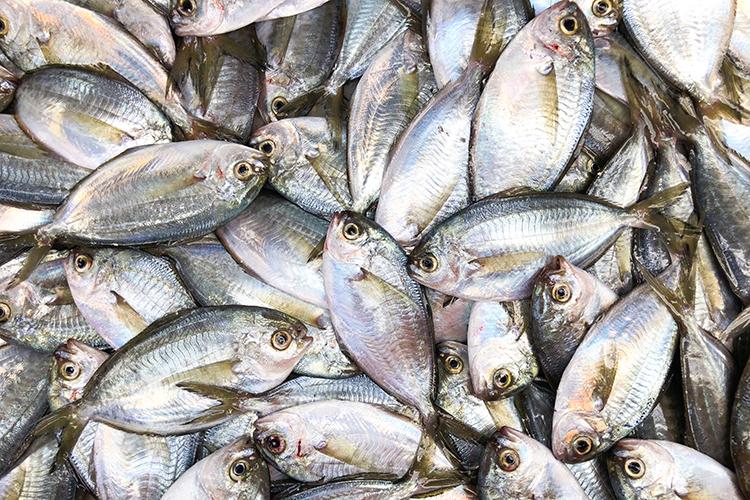We just finished our third and final leg of the fall bottom trawl survey on the NOAA Ship Henry B. Bigelow. We started by sampling our way to the northeast peak of Georges Bank and worked our way west across the northern Gulf of Maine. At one of the stations along the way, we had a really large catch of butterfish. If you look closely, you can see small, dark pores just under the dorsal fin, followed by a high lateral line a little further down. These fish swim in schools and use their beautiful silver color to make it difficult for predators to focus on and attack an individual fish. Hungry predators better their chances to get a meal by breaking up the synchronized swimming school. This forces some butterfish to swim by themselves and become an easier target.
In stark contrast to the silver butterfish is the shimmering greenish-brown red hake. When they arrive at the surface in good condition, their deep, earthy color helps them stand out from the rest of the catch. Unfortunately, they are sensitive to the rapid pressure change when the net comes to the surface. This can cause their eyes to bulge out and stomachs to escape through their mouths.
One little fellow we found among a catch was this small Atlantic wolffish. These fish have vicious teeth and can grow up to 4 to 5 feet long. This specimen isn’t nearly as threatening as an adult, but you can see it already has strong jaws.
For this trip I was on the night shift, midnight to noon, and that means I get to enjoy beautiful sunrises. Watching the sky slowly turn bright red and orange never gets old. Each sunrise seems more spectacular than the last. The sunrise is an opportunity to stop and enjoy the beauty of nature and life at sea. It also means breakfast will be ready shortly. Typically, we can expect eggs, bacon, oatmeal, and pancakes or french toast, so sometimes the smell of breakfast will remind us to look out the window.
Sisters Sabrina and Cassandra Dahl had the opportunity to sail as scientists and work together on the day shift. Sabrina was able to join the survey for leg 1 and came back for another leg. Sabrina said, “My favorite part of being out here is getting to see and learn about all of the diverse fishes since most of my past experience has been with shellfish. It gives a new appreciation for the waters just offshore from what I've been swimming in for years! My other favorite part is being able to work alongside my sister.” This is Cassandra’s first trip. She had fun and said, “I've enjoyed learning from scientists out here in the field and who are using this data back in the lab. Understanding why we are collecting the samples that we are and how they are being used gives me a really meaningful connection to the work that we're doing out here.”








